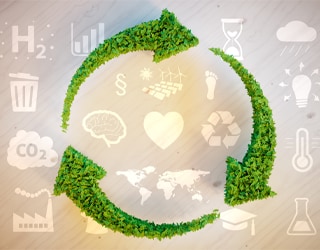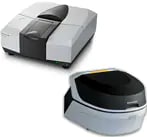AABC (Advanced Automotive Battery Conference) 2025
December 9-11
Caesars Palace
Las Vegas, NV

The goal of a circular economy is to reduce waste and pollution by harvesting materials from renewable sources and reusing materials through recycling, repurposing, and reprocessing. Shimadzu instruments are used by leading scientists worldwide to develop new materials and manufacturing processes that both enhance product performance and reduce harmful environmental impacts in all phases of the circular economy from basic chemical characterization of raw materials and waste streams to the measurement of novel material properties.
Commonly recycled plastics, such as polyethylene, polypropylene, polystyrene, and polyethylene terephthalate, are subject to quality standards to verify their composition and prevent contamination of recycling streams. This can be achieved using analytical instrumentation such at Fourier-Transform Infrared Spectroscopy (FTIR) and Energy Dispersive X-Ray Fluorescence (EDX). Harvesting materials and fuels from waste and renewable sources requires extensive testing to monitor processing steps and ensure purity using, for instance, gas chromatography (GC), liquid chromatography (LC), or elemental analysis.
Renewable materials are also being explored for the creation of bio-based materials and composites with properties that are comparable to plastics created from petroleum. Their physical properties can be evaluated using Shimadzu’s AGX-V universal test machines, thermal instrumentation, and surface analysis. Raw materials derived from hemp are an example where natural products may replace many synthetically manufactured materials. Nanocellulose, a form of defibrated cellulose derived from plant matter, is another material being researched as an environmentally renewable biomaterial with desirable properties, including high strength, thermal stability, and gas-barrier properties.
As a long-standing member of the Japan Association for Chemical Innovation (JACI), Shimadzu Corporation is at the vanguard of the international green Chemistry movement. Shimadzu also constantly strives to reduce its environmental impact through various initiatives to reduce waste and energy consumption.
Hemp in the United States and worldwide is a hot topic because of its green nature, sustainability, and zero or low carbon footprint. While it appears most of the hemp world has been flower-centric on the health benefits of cannabinoids and terpenes, this is only the tip of the iceberg with respect to applications. The entire plant, including flower, seed, stalk, leaves and root, has 50,000 different uses.
This communication will present a limited number of the potential 50,000 different uses. However, Shimadzu is the only worldwide company able to provide analytical instruments, physical testing machines, and X-ray equipment for complete profiling of the hemp plant from development to the final product.
As a consultant for comprehensive analysis of CNF, Shimadzu aim to support research and development to expand the use of CNF. By developing cutting-edge technologies, Shimadzu provides solutions for detailed analysis of CNF properties such as optical transmittance morphology, dispersibility, and different surface functional groups. These analyses are further explored in this booklet comprehensively to help you better investigate and characterize nanocellulose materials. These efforts will help accumulate more experimental, theoretical and analytical data, fostering collaborations to help advance this field forward for practical applications in the near future. Shimadzu will help realize dreams for the next generations with the well-being of mankind and the Earth.
Given that cellulose nanofibers (CNFs) offer attractive physical characteristics, such as light weight, strength, and hardness, they not only enable materials with advanced functionality, but are expected to be used as a reinforcing material that can reduce the weight of composite materials. In contrast to advanced nanomaterials made from petrochemical fuels and inorganic substances, CNFs are made from plant biomass. In addition to being environmentally friendly and safer, they have been confirmed to offer superior performance. Thus, CNFs have started being used in many everyday products, such as rip-resistant disposable wipes, ballpoint pen ink, cosmetics that provide a young appearance without feeling sticky, and waterproof cosmetic face masks. Applications for CNFs are expected to continue expanding; examples include lighter and stronger CNF polymer composite materials used as structural materials in aircraft and transparent CNF panels enhanced with functionality for conductivity.
Biodegradable Plastics are plastics that are decomposed into low-molecular compounds by microorganisms in the environment. So they break down easily in nature, which is an opposite characteristic of petroleum-based plastics. They are recommended for single-use products. At this time, it is true they are inferior to petroleum-based plastics in the features of durability and functionality, so research and development of new materials is on going for a reliable solution.

The main four components of recycled plastics are polyethylene (PE), polypropylene (PP), polystyrene (PS), and polyethylene terephthalate (PET), which are all commodity resins. Quality standards are defined for recycled plastics and to determine the composition of components, generally a sample is dissolved in a solvent and then analyzed using a nuclear magnetic resonance (NMR) spectrometer. In place of this general method, this article introduces a screening analysis method using a Fourier transform infrared spectrophotometer (FTIR). Quantitation is possible by either the individual calculation method, in which the concentration of each component is calculated individually, or the mixing ratio calculation method, in which the concentration of each component is calculated by taking the sample as a whole as 100 %. This article studies the mixing ratio calculation method. A major feature of this method is that unlike the precision analysis using an NMR spectrometer, sample pretreatment is unnecessary and therefore speedy calculations of the composition of components are possible.

In recent years, recycling related laws have been enforced for the purpose of global environmental preservation, which in turn has increased the amount of recycled plastic products around us. This trend entails the needs of rapid and detailed analyses of recycled products. In such cases, sufficient information may be obtained by analyzing not the entire polymers but oligomers. Conventionally, oligomers are analyzed by combining rough separation using the dissolution/reprecipitation method, etc., and various chromatographic or spectroscopic techniques. On the other hand, recently MALDI-TOF mass spectrometers are extensively used for oligomer analysis. By using such instruments, the information of terminal groups and monomer units can be obtained rapidly. This article introduces an example analysis of polycarbonate, which was performed by combining rough separation of oligomers by the dissolution/reprecipitation method and measurement and analysis using the benchtop MALDI-TOF mass spectrometer "MALDI-8020".

The causes of deterioration and breakup of fishing nets are contact with fish, algae, and stones in the sea and on beaches, as well as ultraviolet radiation from the sun. An example of a way to prevent this kind of naturally occurring damage and continue using fishing nets over a long period of time is to give the surface of fishing nets used for aquaculture a protective coating of copper as shown in Fig. 2 (1). Fig. 2 Fishing Net Used for Aquaculture The heavy element copper (Cu) used for the protective coating has an antibacterial effect and not only protects against bacteria and viruses but also has the function of preventing fouling, so it plays an important role on fishing nets. Copper not only maintains the strength of the fishing nets, but also gives excellent functionality. However, in recent years it has been reported that it might have a negative impact on fish and the marine environment, and its use has been a concern. This article introduces an example of analysis using FTIR and EDX on actual fishing nets collected on the Playa de Muro beach on the Spanish island of Majorca and the Paal 9 beach on the island of Texel in the Netherlands, and on fishing nets obtained from a recycling plant.
On May 23, Shimadzu Corporation concluded a comprehensive partnership agreement with Ryukoku University (located in Kyoto, Japan) intended to contribute to creating a recycling-oriented society. Under this agreement, the university will join our closed-loop recycling system, the first of its kind in Japan, in which packaging materials generated by Shimadzu are recycled into polyethylene containers for in-house use.
International Institute for Carbon-Neutral Energy Research, Kyushu University
We spoke with Associate Professor Taniguchi of the International Institute for Carbon-Neutral Energy Research at Kyushu University, who is working on research to solve these two important environmental problems.
Bioplastic Packaging Materials
Shimadzu is continuously improving energy efficiency and making all our products more compact to minimize the environmental impact throughout the entire product life cycle. At the same time, we actively procure parts and materials that reduce the environmental impact of packaging and other secondary materials.
Shimadzu offers “Eco-Products Plus” certified products that achieve an exceptionally high environmental performance. Specifically, “Eco-Products Plus” models are certified by Shimadzu to achieve at least a 25 % reduction in power consumption, size, and/or consumables usage compared to the previous model.
For the Earth, For the Future – Environmental Analytical and Measuring Instruments
Rapid global economic and societal growth and development have resulted in problems with large storms, flooding, and other natural disasters from climate change and problems with environmental pollution from large quantities of waste and hazardous substances. At Shimadzu, in an effort to help solve environmental challenges and achieve sustainable development goals, we contribute to establishing a sustainable society by offering a wide variety of instruments and services for analyzing and measuring the environment.
Modern plastics are highly regulated, especially food packaging. The problem for plastic recyclates is even greater; these are complex mixtures from the past that have to meet modern requirements. For identification and contaminant analyses, FTIR-ATR is a helpful tool. Element analyses (EDX and ICPE) help us to qualify and quantify possible additives (heavy metals) from the past. Mechanical property evaluations with the Autograph also provide important information as part of this component analysis, contributing to the effective reuse of plastics.